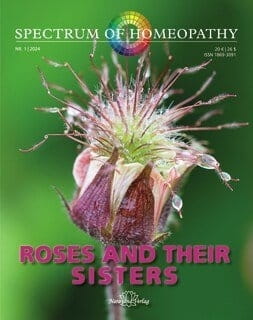Roses and their Sisters - Spectrum of Homeopathy 2024/1
“A rose is a rose is a rose.” This phrase from Gertrude Stein’s poem “Sacred Emily” is often quoted when something is entirely clear. In this edition of SPECTRUM you will see that things are not necessarily so clear cut for Rosidae, Rosales and Rosaceae. In the highly branched clan of “Roses and Their Sisters” we can find the proud and beautiful hybrid tea roses as well as their wild and unkempt but often very useful siblings. The substantial differences in the members of this large family are reflected in our ambivalent attitude to the rose. The intoxicating scent and the magic that they exude has made them a symbol of sensuality and romantic love. At the same time they represent transience, pain and violation.
In contributions to this issue we find many varieties of love: there is the self-love of the proud and beautiful Rosa damascena, the idealising and suffocating love of Agrimonia eupatoria, the love of work characteristic of Hippophae rhamnoides or the spiritual love of Ficus carica. The fig tree belongs just as much to the Rosidae as do the sea buckthorn tree and common agrimony. According to the Conquist classification used by Michal Yakir and Rajan Sankaran, the Rosidae are subclass 5 in the dicotyledonous flowering plants. These two pioneers of homeopathy present their own contributions on this subclass, based on human individuation (Yakir) and the sensation method (Sankaran). Their insights and those of Jan Scholten’s plant theory play a major role in the case analyses in this issue. The authors present numerous instructive examples for the practical application of the differing homeopathic plant systems.
The diversity and contradictions in the rose garden are reflected in the case histories of our international authors on the Rosales and various remedies from the related orders of the Rosidae. This issue of SPECTRUM clarifies the group picture of the rose clans, helping us to recognise the subclass, order and family of the roses in practice so that Laurie Dack convincingly titles her piece on the touching story of the collapsing baby: “A Rose is a rose is a rose.” In this case Laurocerasus is the simillimum for both mother and child. It runs in the family.
- Author: Narayana Verlag
- ISBN: 9783955822781
- Paperback
- Published in 2024
- Printed in Germany

